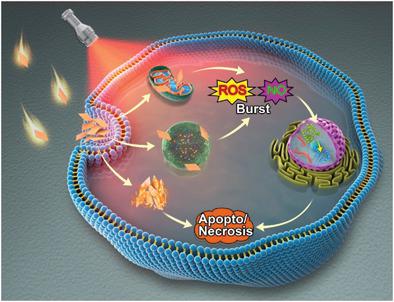Our official English website, www.x-mol.net, welcomes your feedback! (Note: you will need to create a separate account there.)
Photothermal and Enhanced Photocatalytic Therapies Conduce to Synergistic Anticancer Phototherapy with Biodegradable Titanium Diselenide Nanosheets
Small ( IF 13.3 ) Pub Date : 2021-09-06 , DOI: 10.1002/smll.202103239 Yanhong Duo 1, 2 , Guanghong Luo 1, 2, 3 , Zihuang Li 1, 2 , Zide Chen 1, 2 , Xianming Li 1, 2 , Zhenyou Jiang 1, 2, 4 , Binlu Yu 3 , Hao Huang 3 , Zhengbo Sun 3 , Xue-Feng Yu 3
Small ( IF 13.3 ) Pub Date : 2021-09-06 , DOI: 10.1002/smll.202103239 Yanhong Duo 1, 2 , Guanghong Luo 1, 2, 3 , Zihuang Li 1, 2 , Zide Chen 1, 2 , Xianming Li 1, 2 , Zhenyou Jiang 1, 2, 4 , Binlu Yu 3 , Hao Huang 3 , Zhengbo Sun 3 , Xue-Feng Yu 3
Affiliation

|
Nanomaterial-based photothermal and photocatalytic therapies are effective against various types of cancers. However, combining two or more materials is considered necessary to achieve the synergistic anticancer effects of photothermal and photocatalytic therapy, which made the preparation process complicated. Herein, the authors describe simple 2D titanium diselenide (TiSe2) nanosheets (NSs) that can couple photothermal therapy with photocatalytic therapy. The TiSe2 NSs are prepared using a liquid exfoliation method. They show a layered structure and possess high photothermal conversion efficiency (65.58%) and good biocompatibility. Notably, upon near-infrared irradiation, these NSs exhibit good photocatalytic properties with enhanced reactive oxygen species generation and H2O2 decomposition in vitro. They can also achieve high temperatures, with heat improving their catalytic ability to further amplify oxidative stress and glutathione depletion in cancer cells. Furthermore, molecular mechanism studies reveal that the synergistic effects of photothermal and enhanced photocatalytic therapy can simultaneously lead to apoptosis and necrosis in cancer cells via the HSP90/JAK3/NF-κB/IKB-α/Caspase-3 pathway. Systemic exploration reveals that the TiSe2 NSs has an appreciable degradation rate and accumulates passively in tumor tissue, where they facilitate photothermal and photocatalytic effects without obvious toxicity. Their study thus indicates the high potential of biodegradable TiSe2 NSs in synergistic phototherapy for cancer treatment.
中文翻译:

光热和增强光催化疗法有助于与可生物降解的二硒化钛纳米片协同抗癌光疗法
基于纳米材料的光热和光催化疗法可有效对抗各种类型的癌症。然而,为了实现光热和光催化治疗的协同抗癌作用,需要将两种或多种材料结合起来,这使得制备过程变得复杂。在此,作者描述了简单的二维二硒化钛 (TiSe 2 ) 纳米片 (NSs),它可以将光热疗法与光催化疗法结合起来。TiSe 2 NSs 是使用液体剥离方法制备的。它们呈层状结构,具有高光热转换效率(65.58%)和良好的生物相容性。值得注意的是,在近红外辐射下,这些 NSs 表现出良好的光催化性能,增强了活性氧的产生和 H2 O 2体外分解。它们还可以达到高温,通过加热提高它们的催化能力,进一步放大癌细胞中的氧化应激和谷胱甘肽消耗。此外,分子机制研究表明,光热和增强光催化治疗的协同作用可通过 HSP90/JAK3/NF-κB/IKB-α/Caspase-3 通路同时导致癌细胞凋亡和坏死。系统探索表明,TiSe 2 NSs 具有可观的降解率并在肿瘤组织中被动积累,在那里它们促进光热和光催化作用而没有明显的毒性。因此,他们的研究表明可生物降解的 TiSe 2具有很高的潜力 NSs 在协同光疗中用于癌症治疗。
更新日期:2021-10-06
中文翻译:

光热和增强光催化疗法有助于与可生物降解的二硒化钛纳米片协同抗癌光疗法
基于纳米材料的光热和光催化疗法可有效对抗各种类型的癌症。然而,为了实现光热和光催化治疗的协同抗癌作用,需要将两种或多种材料结合起来,这使得制备过程变得复杂。在此,作者描述了简单的二维二硒化钛 (TiSe 2 ) 纳米片 (NSs),它可以将光热疗法与光催化疗法结合起来。TiSe 2 NSs 是使用液体剥离方法制备的。它们呈层状结构,具有高光热转换效率(65.58%)和良好的生物相容性。值得注意的是,在近红外辐射下,这些 NSs 表现出良好的光催化性能,增强了活性氧的产生和 H2 O 2体外分解。它们还可以达到高温,通过加热提高它们的催化能力,进一步放大癌细胞中的氧化应激和谷胱甘肽消耗。此外,分子机制研究表明,光热和增强光催化治疗的协同作用可通过 HSP90/JAK3/NF-κB/IKB-α/Caspase-3 通路同时导致癌细胞凋亡和坏死。系统探索表明,TiSe 2 NSs 具有可观的降解率并在肿瘤组织中被动积累,在那里它们促进光热和光催化作用而没有明显的毒性。因此,他们的研究表明可生物降解的 TiSe 2具有很高的潜力 NSs 在协同光疗中用于癌症治疗。



























 京公网安备 11010802027423号
京公网安备 11010802027423号